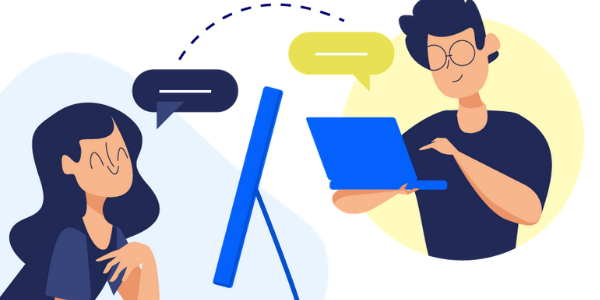Surprise! Can you Demo…
Proper discovery is important for a million reasons, but the one we’re going to focus on today is how discovery dictates what you cover in each demo.

Recall the virtual fundamentals drilled into your head from the past as we're about to revisit them, but again more specifically in regard to Discovery. First and foremost, the visual connection created with the person you are interviewing is telling. You know this from your in-person visits. Encourage your prospect or client to have a webcam ready for the upcoming meeting and be prepared to help guide them in its use. They'll arrive on screen in a more professional mindset, and you can watch their face for a reaction. Ensure proper lighting (no window behind you) and use your digital headset and microphone. If this is a scheduled Discovery (versus a demo requiring Discovery-On-The-Fly), judgment because you are wearing a headset is unlikely. What is critical is that you hear every word they say! Language or accent variations can be minimized by using a headset. Additionally, your digital, noise-cancelling microphone will clearly convey your inquiries, reduce background noise, and increase interviewee comprehension.
-1.png?width=600&height=300&name=Copy%20of%20Copy%20of%20Untitled%20(1)-1.png)
The last Discovery consideration is recording the interview. Virtual interviews can easily be recorded and as such, provide a distinct advantage over in-person interviews. Naturally, you'll need the permission of the individual or group you are interviewing to allow the recording. If allowed, a replay of the interview can be enlightening when heard a second time. You may even discover important but subtle expressions or reactions that you missed during the interview!
Virtual discoveries offer the advantage of letting you type notes throughout the interview. To do this in-person is awkward for the interviewee. Make note-taking easy on yourself and have two screens running. One screen has the interviewee on camera, while the other has your interview guide and notes. Let the interviewee know that you will be typing your responses, and make sure to use a silent keyboard. Multiple screens can be a challenge if you are traveling or otherwise out of your office. Try downloading an app called Duet. It allows your iPad or Android tablet to be a second screen through the standard charging cable connected to your laptop. It works great!
Many of us have been taught to always ask open-ended questions during Discovery. The rationale is that open-ended questions get people talking and reveal valuable information. At 2Win, we believe in open-ended questions, but always at the right time! In the early stages of a virtual Discovery, there is often discomfort on the interviewee's side. This discomfort is a symptom of a lack of trust and credibility. Don't take that to mean this person thinks you're untrustworthy! The interviewee doesn't know you yet. Build trust and credibility with this simple tip: Ask leading open-ended questions that contain insight that they may not have considered. For example, assume you are selling or demonstrating big-data analytics software. In that case, a leading, open-ended question might sound something like, "Angela, it has been my experience that many analysts like yourself have ample, unstructured data that is ripe for mining, but their analytic tools limit their ability to identify meaningful patterns that define the customer trends product management needs. Can you talk to me about your analytical tools and if you relate to my experience? A leading, open-ended question like that might get Angela trusting and talking!
Most discoveries aim to uncover pain and problems, but they don't explore the impact of the positive change your solution can provide. At 2Win, we encourage our clients to CDIM: Current, Desired, Impact and Metric. The goal is to go beyond uncovering how they currently do something (pain), and what they desire (pain-relief). You also want to learn the impact of moving from current to desired and how that might be measured in the form of a metric. BUT, don't be robotic or weird by asking CDIM on every question! Look for natural openings to explore impact and metric.
If your Discovery is with an Individual Contributor (IC), you'll focus your line of questioning on the Current challenges they face in their role. You can expect responses that relate to their job such as "…it takes a long time to…" or "…I have to do the work two times due to …". These types of responses are good information to know and lay the groundwork for your demo to address their Desired. However, your ability to financially justify your solution is tied to the value (Metric) of moving from an IC's current situation to the overriding Desired state. Most IC's will not know how to quantify that value in the form of a Metric, but their manager might. So when you ask them the Impact of moving from Current to Desired, and they respond with "I'm not really sure," ask them who might have the answer. That question will often help you drive-up in an organization, and broaden your team's "influence-footprint." This strategy of driving-up in an organization will lay the groundwork for opening and closing your meeting, demo, or final presentation with VALUE that resonates with all roles within your opportunity.
Assume you were fortunate enough to enter this opportunity from the top of an organization. Perhaps the Director of Finance at your prospect watched a webinar that hit-home with what her organization was experiencing. Next, she reached out to your company to learn more. We refer to these as Top-Down opportunities. If your first Discovery is with her, use leading, open-ended, insight-based questions to drive to the value she seeks from the outset. In all likelihood, she will need you to talk to her managers and team members to get their buy-in for a project of this magnitude. When the meeting is concluding, she will often provide you with her executive assistant's name to contact her team members. When that happens, say this: "Tesandra, as I interview your team members, it has been my experience that I learn things that executives like yourself would find valuable (have some examples ready). What I'll do is summarize those insights and schedule a short, fifteen-minute meeting to share those items with you via your Executive Assistant. I give you my word I'll get right to the point! Would that be okay?" This tip works for me almost every time I use it because, by the end of our conversation, I've established trust, and credibility and the executive is wise enough to know that her people don't tell her everything! Your follow-up isn't meant to be a tell-all meeting about her team members, but rather something a trusted-advisor would share for enlightenment.
At the end of every Discovery interview, we always recommend asking the prospect or client some key questions. We refer to these as "pearls" because, when they answer the questions, they often reveal information like a rare oyster reveals a pearl. It is imperative that you never rush to these questions early or in the middle of the interview. These questions can only be asked after your trust and credibility are at their highest point, ultimately at the end of the conversation. It often sounds like the following:
"Marko, thank you for sharing all of this information with me. I'll use it in the demo to make it as relevant to your needs as possible. I only have a couple of final questions. Of all the things we talked about (or didn't), what are the one, two, or three challenges you're facing at (insert company name) that are most important to you that we solve?"
Next question:
"Finally, if the decision were up to you to make and it only affected you or your department, why would you recommend changing from what you use today to a new solution (process or product)?"
There you have it! Even if you are working from a fifty-page RFP and Demo Script, these questions will tell you where to prioritize your next conversation, demo, or proposal presentation. The answers to these questions are a tremendous source of "insights" you can deliver to the executive in charge of the selection. Seek opinions on priorities and validate where you should place your emphasis.
Discovery ahead of the initial presentation or deep-dive demo is almost always ideal. But, what happens if you are thrown into a situation where you've had minimal Discovery or none at all? Our research points to a significant number of demos being performed with "underknown" Discovery. That's the term we use for situations where you had only limited access to the prospect ahead of a demo, and the people you spoke to represent everyone that will be in attendance at the demo. When this happens, your value messages based on your "Pearls" are at risk of not aligning with the audience. If this is your reality and someone on your virtual demo interrupts with, "I have a request. Can you show us how you (fill in the blank)? Careful! I'd encourage you not to start demoing. Pause, gather your thoughts, and clarify what they want to see through active listening. Reflect back to this person their request. Make sure you truly understand what it is that they want to see. Next, ask a couple of Discovery-On-The-Fly (OTF) questions about the request. In certain situations, CDIM! Now, you can either demo or, table the request if you aren't able to show something. If this person is an IC, offer to learn more about their needs later to avoid derailing your demo's flow (and momentum).
Executives are the exception to a strategic delay for demoing to their request. You should still reflect and clarify (maybe even ask impact and metric), but if you can demo right now, do it! Most executives lack the patience of scheduling and attending a follow-up meeting. They want the information now, so give it to them. If you can't show it now (due to a configuration issue or lack of functionality), offer to make a custom video and send it to them. Doing so will avoid the delay in scheduling a follow-up meeting.
Successful Discovery in 2024 requires adapting methods in the past for today's reality. Don't assume that superior product knowledge or demo skills are a replacement for Discovery. At 2Win, we know that every demo, meeting, or presentation deserves a Discovery. If you don't get Discovery ahead of one of those events, the event becomes the Discovery. Either way, use these techniques, and you'll see an immediate improvement in how your demos, meetings, and presentations connect with stakeholders.

Proper discovery is important for a million reasons, but the one we’re going to focus on today is how discovery dictates what you cover in each demo.

There are three steps to Applying Discovery: What did we learn in CDIM? The processing part is internalizing what we've heard to determine a...

What makes a sales organization powerful? What makes a sales organization effective? How are the biggest and best sales teams meeting goals? The most...